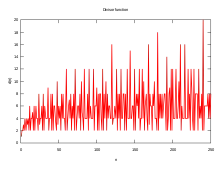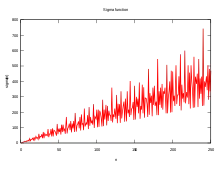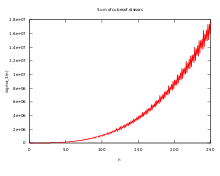Divisor function
In mathematics, and specifically in number theory, a divisor function is an arithmetic function related to the divisors of an integer. When referred to as the divisor function, it counts the number of divisors of an integer (including 1 and the number itself). It appears in a number of remarkable identities, including relationships on the Riemann zeta function and the Eisenstein series of modular forms. Divisor functions were studied by Ramanujan, who gave a number of important congruences and identities; these are treated separately in the article Ramanujan's sum.




A related function is the divisor summatory function, which, as the name implies, is a sum over the divisor function.
Definition
The sum of positive divisors function σx(n), for a real or complex number x, is defined as the sum of the xth powers of the positive divisors of n. It can be expressed in sigma notation as
where is shorthand for "d divides n". The notations d(n), ν(n) and τ(n) (for the German Teiler = divisors) are also used to denote σ0(n), or the number-of-divisors function[1][2] (OEIS: A000005). When x is 1, the function is called the sigma function or sum-of-divisors function,[1][3] and the subscript is often omitted, so σ(n) is the same as σ1(n) (OEIS: A000203).
The aliquot sum s(n) of n is the sum of the proper divisors (that is, the divisors excluding n itself, OEIS: A001065), and equals σ1(n) − n; the aliquot sequence of n is formed by repeatedly applying the aliquot sum function.
Example
For example, σ0(12) is the number of the divisors of 12:
while σ1(12) is the sum of all the divisors:
and the aliquot sum s(12) of proper divisors is:
Table of values
The cases x = 2 to 5 are listed in OEIS: A001157 − OEIS: A001160, x = 6 to 24 are listed in OEIS: A013954 − OEIS: A013972.
| n | factorization | σ0(n) | σ1(n) | σ2(n) | σ3(n) | σ4(n) |
|---|---|---|---|---|---|---|
| 1 | 1 | 1 | 1 | 1 | 1 | 1 |
| 2 | 2 | 2 | 3 | 5 | 9 | 17 |
| 3 | 3 | 2 | 4 | 10 | 28 | 82 |
| 4 | 22 | 3 | 7 | 21 | 73 | 273 |
| 5 | 5 | 2 | 6 | 26 | 126 | 626 |
| 6 | 2×3 | 4 | 12 | 50 | 252 | 1394 |
| 7 | 7 | 2 | 8 | 50 | 344 | 2402 |
| 8 | 23 | 4 | 15 | 85 | 585 | 4369 |
| 9 | 32 | 3 | 13 | 91 | 757 | 6643 |
| 10 | 2×5 | 4 | 18 | 130 | 1134 | 10642 |
| 11 | 11 | 2 | 12 | 122 | 1332 | 14642 |
| 12 | 22×3 | 6 | 28 | 210 | 2044 | 22386 |
| 13 | 13 | 2 | 14 | 170 | 2198 | 28562 |
| 14 | 2×7 | 4 | 24 | 250 | 3096 | 40834 |
| 15 | 3×5 | 4 | 24 | 260 | 3528 | 51332 |
| 16 | 24 | 5 | 31 | 341 | 4681 | 69905 |
| 17 | 17 | 2 | 18 | 290 | 4914 | 83522 |
| 18 | 2×32 | 6 | 39 | 455 | 6813 | 112931 |
| 19 | 19 | 2 | 20 | 362 | 6860 | 130322 |
| 20 | 22×5 | 6 | 42 | 546 | 9198 | 170898 |
| 21 | 3×7 | 4 | 32 | 500 | 9632 | 196964 |
| 22 | 2×11 | 4 | 36 | 610 | 11988 | 248914 |
| 23 | 23 | 2 | 24 | 530 | 12168 | 279842 |
| 24 | 23×3 | 8 | 60 | 850 | 16380 | 358258 |
| 25 | 52 | 3 | 31 | 651 | 15751 | 391251 |
| 26 | 2×13 | 4 | 42 | 850 | 19782 | 485554 |
| 27 | 33 | 4 | 40 | 820 | 20440 | 538084 |
| 28 | 22×7 | 6 | 56 | 1050 | 25112 | 655746 |
| 29 | 29 | 2 | 30 | 842 | 24390 | 707282 |
| 30 | 2×3×5 | 8 | 72 | 1300 | 31752 | 872644 |
| 31 | 31 | 2 | 32 | 962 | 29792 | 923522 |
| 32 | 25 | 6 | 63 | 1365 | 37449 | 1118481 |
| 33 | 3×11 | 4 | 48 | 1220 | 37296 | 1200644 |
| 34 | 2×17 | 4 | 54 | 1450 | 44226 | 1419874 |
| 35 | 5×7 | 4 | 48 | 1300 | 43344 | 1503652 |
| 36 | 22×32 | 9 | 91 | 1911 | 55261 | 1813539 |
| 37 | 37 | 2 | 38 | 1370 | 50654 | 1874162 |
| 38 | 2×19 | 4 | 60 | 1810 | 61740 | 2215474 |
| 39 | 3×13 | 4 | 56 | 1700 | 61544 | 2342084 |
| 40 | 23×5 | 8 | 90 | 2210 | 73710 | 2734994 |
| 41 | 41 | 2 | 42 | 1682 | 68922 | 2825762 |
| 42 | 2×3×7 | 8 | 96 | 2500 | 86688 | 3348388 |
| 43 | 43 | 2 | 44 | 1850 | 79508 | 3418802 |
| 44 | 22×11 | 6 | 84 | 2562 | 97236 | 3997266 |
| 45 | 32×5 | 6 | 78 | 2366 | 95382 | 4158518 |
| 46 | 2×23 | 4 | 72 | 2650 | 109512 | 4757314 |
| 47 | 47 | 2 | 48 | 2210 | 103824 | 4879682 |
| 48 | 24×3 | 10 | 124 | 3410 | 131068 | 5732210 |
| 49 | 72 | 3 | 57 | 2451 | 117993 | 5767203 |
| 50 | 2×52 | 6 | 93 | 3255 | 141759 | 6651267 |
Properties
Formulas at prime powers
For a prime number p,
because by definition, the factors of a prime number are 1 and itself. Also, where pn# denotes the primorial,
since n prime factors allow a sequence of binary selection ( or 1) from n terms for each proper divisor formed.
Clearly, and σ(n) > n for all n > 2.
The divisor function is multiplicative, but not completely multiplicative:
The consequence of this is that, if we write
where r = ω(n) is the number of distinct prime factors of n, pi is the ith prime factor, and ai is the maximum power of pi by which n is divisible, then we have: [4]
which, when x ≠ 0, is equivalent to the useful formula: [4]
When x = 0, d(n) is: [4]
For example, if n is 24, there are two prime factors (p1 is 2; p2 is 3); noting that 24 is the product of 23×31, a1 is 3 and a2 is 1. Thus we can calculate as so:
The eight divisors counted by this formula are 1, 2, 4, 8, 3, 6, 12, and 24.
Other properties and identities
Euler proved the remarkable recurrence:[5][6][7]
where we set if it occurs and for , we use the Kronecker delta and are the pentagonal numbers. Indeed, Euler proved this by logarithmic differentiation of the identity in his Pentagonal number theorem.
For a non-square integer, n, every divisor, d, of n is paired with divisor n/d of n and is even; for a square integer, one divisor (namely ) is not paired with a distinct divisor and is odd. Similarly, the number is odd if and only if n is a square or twice a square.
We also note s(n) = σ(n) − n. Here s(n) denotes the sum of the proper divisors of n, that is, the divisors of n excluding n itself. This function is the one used to recognize perfect numbers which are the n for which s(n) = n. If s(n) > n then n is an abundant number and if s(n) < n then n is a deficient number.
If n is a power of 2, for example, , then and s(n) = n - 1, which makes n almost-perfect.
As an example, for two distinct primes p and q with p < q, let
Then
and
where is Euler's totient function.
Then, the roots of:
allow us to express p and q in terms of σ(n) and φ(n) only, without even knowing n or p+q, as:
Also, knowing n and either or (or knowing p+q and either or ) allows us to easily find p and q.
In 1984, Roger Heath-Brown proved that the equality
Series relations
Two Dirichlet series involving the divisor function are: [8]
which for d(n) = σ0(n) gives: [8]
and [9]
A Lambert series involving the divisor function is: [10]
for arbitrary complex |q| ≤ 1 and a. This summation also appears as the Fourier series of the Eisenstein series and the invariants of the Weierstrass elliptic functions.
For exists an explicit series representation with Ramanujan sums as :[11]
The computation of the first terms of shows its oscillations around the "average value" :
Growth rate
In little-o notation, the divisor function satisfies the inequality:[12][13]
More precisely, Severin Wigert showed that:[13]
On the other hand, since there are infinitely many prime numbers,[13]
In Big-O notation, Peter Gustav Lejeune Dirichlet showed that the average order of the divisor function satisfies the following inequality:[14][15]
where is Euler's gamma constant. Improving the bound in this formula is known as Dirichlet's divisor problem.
The behaviour of the sigma function is irregular. The asymptotic growth rate of the sigma function can be expressed by: [16]
where lim sup is the limit superior. This result is Grönwall's theorem, published in 1913 (Grönwall 1913). His proof uses Mertens' 3rd theorem, which says that:
where p denotes a prime.
In 1915, Ramanujan proved that under the assumption of the Riemann hypothesis, the inequality:
- (Robin's inequality)
holds for all sufficiently large n (Ramanujan 1997). The largest known value that violates the inequality is n=5040. In 1984, Guy Robin proved that the inequality is true for all n > 5040 if and only if the Riemann hypothesis is true (Robin 1984). This is Robin's theorem and the inequality became known after him. Robin furthermore showed that if the Riemann hypothesis is false then there are an infinite number of values of n that violate the inequality, and it is known that the smallest such n > 5040 must be superabundant (Akbary & Friggstad 2009). It has been shown that the inequality holds for large odd and square-free integers, and that the Riemann hypothesis is equivalent to the inequality just for n divisible by the fifth power of a prime (Choie et al. 2007).
Robin also proved, unconditionally, that the inequality:
holds for all n ≥ 3.
A related bound was given by Jeffrey Lagarias in 2002, who proved that the Riemann hypothesis is equivalent to the statement that:
for every natural number n > 1, where is the nth harmonic number, (Lagarias 2002).
See also
- Divisor sum convolutions Lists a few identities involving the divisor functions
- Euler's totient function (Euler's phi function)
- Refactorable number
- Table of divisors
- Unitary divisor
Notes
- Long (1972, p. 46)
- Pettofrezzo & Byrkit (1970, p. 63)
- Pettofrezzo & Byrkit (1970, p. 58)
- Hardy & Wright (2008), pp. 310 f, §16.7.
- Euler, Leonhard; Bell, Jordan (2004). "An observation on the sums of divisors". arXiv:math/0411587.
- http://eulerarchive.maa.org//pages/E175.html, Decouverte d'une loi tout extraordinaire des nombres par rapport a la somme de leurs diviseurs
- https://scholarlycommons.pacific.edu/euler-works/542/, De mirabilis proprietatibus numerorum pentagonalium
- Hardy & Wright (2008), pp. 326-328, §17.5.
- Hardy & Wright (2008), pp. 334-337, §17.8.
- Hardy & Wright (2008), pp. 338-341, §17.10.
- E. Krätzel (1981). Zahlentheorie. Berlin: VEB Deutscher Verlag der Wissenschaften. p. 130. (German)
- Apostol (1976), p. 296.
- Hardy & Wright (2008), pp. 342-347, §18.1.
- Apostol (1976), Theorem 3.3.
- Hardy & Wright (2008), pp. 347-350, §18.2.
- Hardy & Wright (2008), pp. 469-471, §22.9.
References
- Akbary, Amir; Friggstad, Zachary (2009), "Superabundant numbers and the Riemann hypothesis" (PDF), American Mathematical Monthly, 116 (3): 273–275, doi:10.4169/193009709X470128, archived from the original (PDF) on 2014-04-11.
- Apostol, Tom M. (1976), Introduction to analytic number theory, Undergraduate Texts in Mathematics, New York-Heidelberg: Springer-Verlag, ISBN 978-0-387-90163-3, MR 0434929, Zbl 0335.10001
- Bach, Eric; Shallit, Jeffrey, Algorithmic Number Theory, volume 1, 1996, MIT Press. ISBN 0-262-02405-5, see page 234 in section 8.8.
- Caveney, Geoffrey; Nicolas, Jean-Louis; Sondow, Jonathan (2011), "Robin's theorem, primes, and a new elementary reformulation of the Riemann Hypothesis" (PDF), INTEGERS: The Electronic Journal of Combinatorial Number Theory, 11: A33, arXiv:1110.5078, Bibcode:2011arXiv1110.5078C
- Choie, YoungJu; Lichiardopol, Nicolas; Moree, Pieter; Solé, Patrick (2007), "On Robin's criterion for the Riemann hypothesis", Journal de théorie des nombres de Bordeaux, 19 (2): 357–372, arXiv:math.NT/0604314, doi:10.5802/jtnb.591, ISSN 1246-7405, MR 2394891, Zbl 1163.11059
- Grönwall, Thomas Hakon (1913), "Some asymptotic expressions in the theory of numbers", Transactions of the American Mathematical Society, 14: 113–122, doi:10.1090/S0002-9947-1913-1500940-6
- Hardy, G. H.; Wright, E. M. (2008) [1938], An Introduction to the Theory of Numbers, Revised by D. R. Heath-Brown and J. H. Silverman. Foreword by Andrew Wiles. (6th ed.), Oxford: Oxford University Press, ISBN 978-0-19-921986-5, MR 2445243, Zbl 1159.11001
- Ivić, Aleksandar (1985), The Riemann zeta-function. The theory of the Riemann zeta-function with applications, A Wiley-Interscience Publication, New York etc.: John Wiley & Sons, pp. 385–440, ISBN 0-471-80634-X, Zbl 0556.10026
- Lagarias, Jeffrey C. (2002), "An elementary problem equivalent to the Riemann hypothesis", The American Mathematical Monthly, 109 (6): 534–543, arXiv:math/0008177, doi:10.2307/2695443, ISSN 0002-9890, JSTOR 2695443, MR 1908008
- Long, Calvin T. (1972), Elementary Introduction to Number Theory (2nd ed.), Lexington: D. C. Heath and Company, LCCN 77171950
- Pettofrezzo, Anthony J.; Byrkit, Donald R. (1970), Elements of Number Theory, Englewood Cliffs: Prentice Hall, LCCN 77081766
- Ramanujan, Srinivasa (1997), "Highly composite numbers, annotated by Jean-Louis Nicolas and Guy Robin", The Ramanujan Journal, 1 (2): 119–153, doi:10.1023/A:1009764017495, ISSN 1382-4090, MR 1606180
- Robin, Guy (1984), "Grandes valeurs de la fonction somme des diviseurs et hypothèse de Riemann", Journal de Mathématiques Pures et Appliquées, Neuvième Série, 63 (2): 187–213, ISSN 0021-7824, MR 0774171
- Williams, Kenneth S. (2011), Number theory in the spirit of Liouville, London Mathematical Society Student Texts, 76, Cambridge: Cambridge University Press, ISBN 978-0-521-17562-3, Zbl 1227.11002
External links
- Weisstein, Eric W. "Divisor Function". MathWorld.
- Weisstein, Eric W. "Robin's Theorem". MathWorld.
- Elementary Evaluation of Certain Convolution Sums Involving Divisor Functions PDF of a paper by Huard, Ou, Spearman, and Williams. Contains elementary (i.e. not relying on the theory of modular forms) proofs of divisor sum convolutions, formulas for the number of ways of representing a number as a sum of triangular numbers, and related results.

